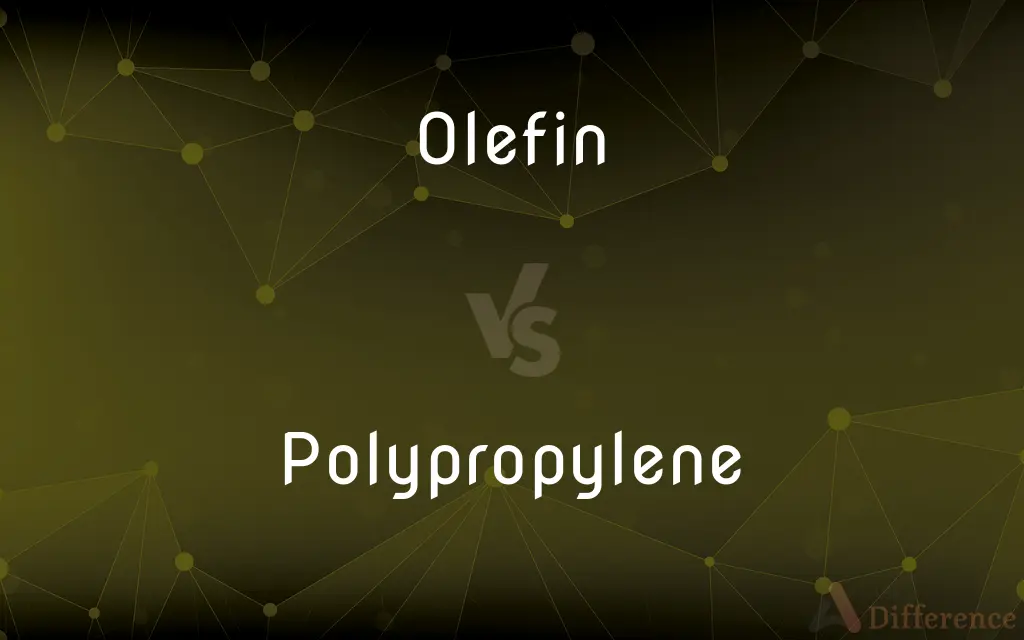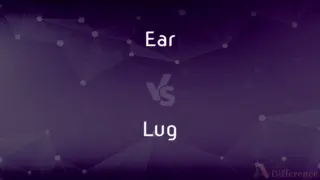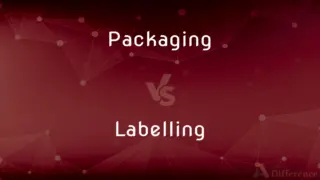Olefin vs. Polypropylene — What's the Difference?
By Tayyaba Rehman & Maham Liaqat — Updated on March 2, 2024
Olefin is a type of hydrocarbon compound that includes a variety of polymers, such as polypropylene, which is a specific type of olefin polymer known for its strength, versatility, and chemical resistance.

Difference Between Olefin and Polypropylene
Table of Contents
ADVERTISEMENT
Key Differences
Olefin refers to a large family of hydrocarbon compounds characterized by the presence of one or more double bonds between carbon atoms, which makes them highly reactive and suitable for polymerization. These compounds are used to produce a wide range of materials, including plastics, fibers, and rubbers. Polypropylene, on the other hand, is a specific type of polymer made from propylene monomers, a member of the olefin family, and is distinguished by its unique properties such as high resistance to chemicals, toughness, and flexibility.
Polypropylene is a subset of olefins, meaning all polypropylene is olefin, but not all olefins are polypropylene. Olefins include a variety of other polymers and monomers, such as ethylene and butylene, each with its own set of properties and applications. Whereas polypropylene is specifically known for its application in packaging, textiles, automotive components, and reusable containers due to its balance of properties and cost-effectiveness.
The production process of olefins involves the cracking of hydrocarbon feedstocks, which produces a range of olefin gases. Polypropylene production specifically involves the polymerization of propylene gas in the presence of a catalyst. This process allows for the creation of long chains of polypropylene, which can be further modified to achieve different material properties.
Olefins, given their broad category, are used across a wide spectrum of industries, from the production of synthetic lubricants to the manufacture of various plastics and elastomers. Polypropylene’s applications are more specific, taking advantage of its durability and resistance to fatigue, making it ideal for products that require repeated use or exposure to harsh conditions.
The environmental impact and recycling capabilities also differ. While olefins as a group can vary widely in their environmental footprint and recyclability, polypropylene is notable for being one of the more recyclable plastics, often identified by the resin identification code "5". Its ability to be melted and reformed without significant degradation allows for its reuse in various applications, contributing to waste reduction efforts.
ADVERTISEMENT
Comparison Chart
Definition
A family of hydrocarbons with double bonds
A polymer made from propylene monomers
Subset Relationship
Broad category including various polymers
Specific type of olefin
Key Properties
Reactive, versatile
Chemical resistance, toughness, flexibility
Applications
Wide range (plastics, fibers, rubbers)
Specific (packaging, textiles, automotive)
Production Process
Cracking of hydrocarbons
Polymerization of propylene with catalyst
Environmental Impact
Varies widely
More recyclable, identified by resin code 5
Compare with Definitions
Olefin
Derived from petroleum cracking.
Cracking processes yield olefins for industrial use.
Polypropylene
A type of plastic polymer.
Polypropylene is popular for making durable food containers.
Olefin
Includes several types of polymers.
Olefins are key in producing different types of plastic.
Polypropylene
Recyclable material.
Polypropylene products are often recycled to reduce plastic waste.
Olefin
Reactive and versatile for polymerization.
Olefins serve as a base for various synthetic materials.
Polypropylene
Known for chemical resistance.
Polypropylene containers can store acidic or basic substances.
Olefin
Used across multiple industries.
Olefins are foundational in manufacturing fibers and elastomers.
Polypropylene
Used in textile manufacturing.
Polypropylene is woven into rugs and mats for its durability.
Olefin
A class of hydrocarbons.
Ethylene is a widely used olefin in the chemical industry.
Polypropylene
Automotive component material.
Polypropylene is used in car batteries and bumpers for its toughness.
Olefin
(organic chemistry) Any of a class of unsaturated open-chain hydrocarbons such as ethylene; an alkene with only one carbon-carbon double bond.
Polypropylene
Polypropylene (PP), also known as polypropene, is a thermoplastic polymer used in a wide variety of applications. It is produced via chain-growth polymerization from the monomer propylene.
Olefin
Any one of the series of unsaturated hydrocarbons of which ethylene is the type; a member of the alkene series of hydrocarbons; an alkene.
Polypropylene
A synthetic resin which is a polymer of propylene, used chiefly for films, fibres, or moulding materials
High-impact polypropylene
Polypropylene underwear
Polypropylene
Any of various thermoplastic polymers of propylene. They are hard and tough, and are used to make molded articles and fibers.
Polypropylene
A fabric of fibers made from any of these polymers.
Polypropylene
A thermoplastic resin made by the polymerization of propylene, and used for films, fibres, or moulding materials. Also known as polypropene.
Polypropylene
A polymer of propylene used as a thermoplastic molding material
Common Curiosities
What is polypropylene?
Polypropylene is a polymer made from propylene monomers, known for its strength, flexibility, and resistance to chemicals.
What is olefin?
Olefin refers to a group of hydrocarbons that contain at least one double bond between carbon atoms, used in producing various polymers.
Can all olefins be recycled like polypropylene?
Not all olefins have the same recyclability as polypropylene, which is identified by resin identification code "5" for its recycling potential.
What are the key applications of polypropylene?
Key applications include packaging materials, textiles, automotive parts, and reusable containers.
Where are olefins commonly used?
Olefins are used in a wide range of applications, from synthetic lubricants and plastics to fibers and elastomers.
How is polypropylene produced?
Through the polymerization of propylene gas in the presence of a catalyst, forming long polymer chains.
Why is polypropylene considered environmentally friendly?
Due to its ability to be recycled multiple times without significant degradation, reducing overall plastic waste.
What makes polypropylene unique among olefins?
Its combination of chemical resistance, durability, and flexibility, along with being recyclable, sets it apart.
How are olefins and polypropylene related?
Polypropylene is a specific type of olefin polymer, making it a subset of the broader olefin family.
What distinguishes olefins from other hydrocarbons?
The presence of one or more double bonds between carbon atoms, which makes them highly reactive and suitable for creating polymers.
Share Your Discovery

Previous Comparison
Ear vs. Lug
Next Comparison
Packaging vs. LabellingAuthor Spotlight
Written by
Tayyaba RehmanTayyaba Rehman is a distinguished writer, currently serving as a primary contributor to askdifference.com. As a researcher in semantics and etymology, Tayyaba's passion for the complexity of languages and their distinctions has found a perfect home on the platform. Tayyaba delves into the intricacies of language, distinguishing between commonly confused words and phrases, thereby providing clarity for readers worldwide.
Co-written by
Maham Liaqat














































